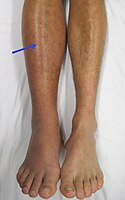
Photo from wikipedia
Inefficient injection of microparticles through conventional hypodermic needles can impose serious challenges on clinical translation of biopharmaceutical drugs and microparticle-based drug formulations. This study aims to determine the important factors… Click to show full abstract
Inefficient injection of microparticles through conventional hypodermic needles can impose serious challenges on clinical translation of biopharmaceutical drugs and microparticle-based drug formulations. This study aims to determine the important factors affecting microparticle injectability and establish a predictive framework using computational fluid dynamics, design of experiments, and machine learning. A numerical multiphysics model was developed to examine microparticle flow and needle blockage in a syringe-needle system. Using experimental data, a simple empirical mathematical model was introduced. Results from injection experiments were subsequently incorporated into an artificial neural network to establish a predictive framework for injectability. Last, simulations and experimental results contributed to the design of a syringe that maximizes injectability in vitro and in vivo. The custom injection system enabled a sixfold increase in injectability of large microparticles compared to a commercial syringe. This study highlights the importance of the proposed framework for optimal injection of microparticle-based drugs by parenteral routes.
Journal Title: Science advances
Year Published: 2020
Link to full text (if available)
Share on Social Media: Sign Up to like & get
recommendations!